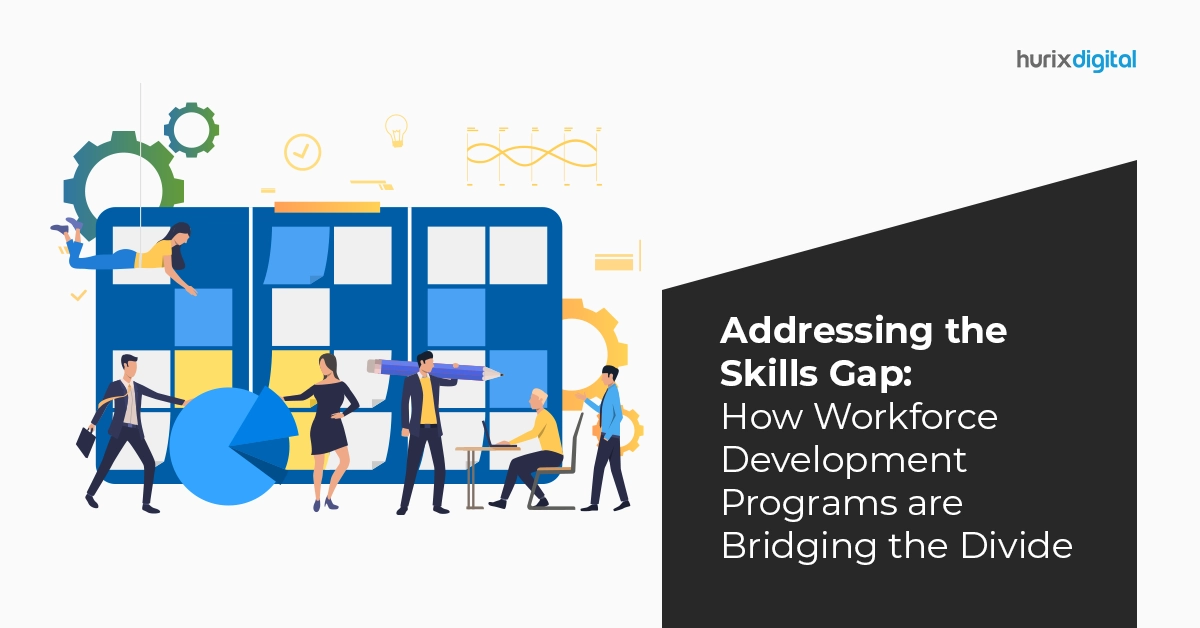
Addressing the Skills Gap: How Workforce Development Programs are Bridging the Divide
Summary
Explore how workforce development programs are addressing skills gaps. This blog discusses strategies for bridging the divide between job requirements and workforce skills.
In today’s rapidly changing global economy, the persistent gap between the skills demanded by companies and the ones possessed by the current workforce has emerged as a critical challenge. This phenomenon, known as the skills gap, is not only affecting the individuals who are seeking employment but also hindering the growth of industries to strive in this competitive market.
According to recent data, 69% of the surveyed professionals believe that their respective organizations suffer from a skills gap, and this has increased by 14% since 2021.
To boost economic growth, enhance productivity, and ensure social equity, addressing the skills gap is paramount. To effectively bridge this gap, it is essential to understand the multifaceted factors that contribute to the skills gap and implement interventions that empower individuals to thrive in the workplace.
Table of Contents:
- Exploring the Root Causes of the Skills Gap
- The Role of Workforce Development Programs to Bridge the Skills Gap
- To Wrap Up
Exploring the Root Causes of the Skills Gap
Understanding the factors that lead to the skills gap is crucial in order to address this issue and implement effective solutions.
Here are the key factors that contribute to the emergence of the skills gap:
1. Technological Advancements
The rapid pace of technological innovations has revolutionized the workplace, which is introducing new job roles that demand specialized and technical skills.
From cybersecurity to artificial intelligence, the fast pace of technological innovations has surpassed the current workforce’s skills. This gap is mostly seen in sectors like manufacturing and agriculture.
2. Demographic Shifts
Demographic changes, such as an aging workforce undergoing demographic shifts, also play a crucial role in exacerbating the skills gap. As experienced workers retire and move to a different demographic place, there aren’t enough skilled workers to replace them.
The transition is coupled with the newer generation’s different expectations and educational backgrounds. They prefer different work environments and other specialized skills that the older generation possesses.
3. Globalization and Economic Trends
The global expansion of companies has intensified competition in the labor market, which requires workers to possess skills to stay relevant and competitive.
Understanding global markets, language skills, and cultural competency are now critical skills required by businesses to stay competitive. Economic trends such as outsourcing and offshoring can create an imbalance in the global market.
4. Business Model Innovation
There is a paradigm shift in the thought concept, which is leaning towards more service-oriented and knowledge-oriented economies, which has further expanded the skills gap.
Also Read: How Does Game-Based Learning Redefine Product Sales Training?
The Role of Workforce Development Programs to Bridge the Skills Gap
Here’s how workforce development programs are addressing the skills gap:
1. Customized Skill Enhancement
These programs identify the specific skills required by the local industries and create tailored training programs to address those needs. This ensures that the participants have acquired the necessary skills, which are immediately applicable in the job market.
For example, if a company has identified a gap in digital marketing skills, it can implement targeted workforce training initiatives to upskill the marketing team in that area.
2. Boosting Industry and Education Collaboration
Closing the skills gap requires effective collaboration between industry and educational institutions. Programs for workforce development act as bridges to create alliances that are advantageous to both parties.
As part of this partnership, the leaders in the industry will be influencing the curriculum to include the knowledge and abilities that they are looking for in potential workers. Initiatives to educate the workforce can also be carried out through work-study, apprenticeships, or internships, which provide prospective workers with real-world experience and exposure to business procedures.
3. Encouraging Lifetime Education
A key component of workforce training programs is encouraging a culture of continual learning and progress, which goes beyond the acquisition of particular skills.
These programs emphasize reskilling and upskilling, enabling people to maintain their competitive edge and flexibility throughout their professional lives.
This culture promotes workplace learning initiatives that benefit individuals as well as the general resilience and vitality of the company by encouraging staff members to look for learning opportunities on their own.
4. Flexibility and Adaptability
The prerequisites of a modern business environment require agility and flexibility, which can be instilled by workforce training programs.
By continuously updating training content to reflect the latest technological and industry trends, organizations can ensure that their employees are updated with the latest trends and ready to adapt to new challenges.
5. Inclusion and Diversity
Workforce development programs prioritize inclusion and diversity by reaching out to underrepresented groups, such as minorities and disabled individuals.
They create inclusive learning environments and tailor their programs to address the unique needs and challenges faced by these populations, thereby promoting equity in the workplace and expanding the talent pool.
6. Augmenting Soft Skills
While the skills gap is basically due to technical competencies, there is a significant gap in soft skills such as communication, leadership, and teamwork. Training programs include professional skills enhancement, which is crucial for creating well-rounded, adaptable employees capable of leading, innovating, and working efficiently in diverse teams.
Also Read: Level-Up Your Training with a Combination of Microlearning and Mobile Learning
To Wrap Up
By implementing skills gap solutions, the full potential of employees can be utilized to drive economic growth and build a more resilient society for generations to come.
Additionally, closing the skills gap can lead to reduced unemployment rates, increased productivity, and improved overall well-being for individuals and communities. It can also enhance innovation and competitiveness in industries, leading to sustainable economic development.
Moreover, addressing the skills gap fosters inclusivity by providing opportunities for individuals from diverse backgrounds to access education, training, and employment. This can help reduce inequality and create a more equitable society.
In this regard, partnering with Hurix Digital can help you leverage innovative digital learning solutions to bridge the skills gap effectively. We offer customized e-learning platforms, content development services, and learning management systems tailored to the specific needs of your organization.
Contact us to get started!

Performance, Results, Growth, and Life-Long Learning define my professional life. I am passionate about making workplace learning planful, purposeful, and impactful. I take pride in partnering with clients and bringing them the best in learning design and creating solutions that address business challenges.




